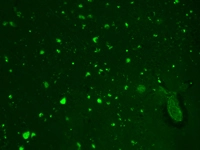HCN2 Antibody (OASE00155)
OASE00155
ApplicationsImmunoFluorescence, ImmunoPrecipitation, Western Blot, ImmunoCytoChemistry, ImmunoHistoChemistry, Other Application
Product group Antibodies
TargetHcn2
Overview
- SupplierAviva Systems Biology
- Product NameHCN2 Antibody (OASE00155)
- Delivery Days Customer23
- ApplicationsImmunoFluorescence, ImmunoPrecipitation, Western Blot, ImmunoCytoChemistry, ImmunoHistoChemistry, Other Application
- CertificationResearch Use Only
- ClonalityMonoclonal
- Clone IDS71
- Concentration1 mg/ml
- ConjugateUnconjugated
- FormatLiquid PBS pH 7.4, 50% glycerol, 0.09% sodium azide
- Gene ID114244
- Target nameHcn2
- Target descriptionhyperpolarization activated cyclic nucleotide gated potassium and sodium channel 2
- Target synonymspotassium/sodium hyperpolarization-activated cyclic nucleotide-gated channel 2, hyperpolarization activated cyclic nucleotide-gated potassium channel 2
- HostMouse
- IsotypeIgG1
- Scientific DescriptionHyperpolarization-activated cyclic nucleotide-gated ion channel 2 (HCN2) is an integral membrane protein that helps establish and control the small voltage gradient across the plasma membrane of living cells by allowing the flow of ions down their electrochemical gradient (1). Ion channels are present in the membranes that surround all biological cells because their main function is to regulate the flow of ions across this membrane. Whereas some ion channels permit the passage of ions based on charge, others conduct based on a ionic species, such as sodium or potassium. Furthermore, in some ion channels, the passage is governed by a gate which is controlled by chemical or electrical signals, temperature, or mechanical forces. There are a few main classifications of gated ion channels. There are voltage- gated ion channels, ligand- gated, other gating systems and finally those that are classified differently, having more exotic characteristics. The first are voltage- gated ion channels which open and close in response to membrane potential. These are then separated into sodium, calcium, potassium, proton, transient receptor, and cyclic nucleotide-gated channels; each of which is responsible for a unique role. Ligand-gated ion channels are also known as ionotropic receptors, and they open in response to specific ligand molecules binding to the extracellular domain of the receptor protein. The other gated classifications include activation and inactivation by second messengers, inward-rectifier potassium channels, calcium-activated potassium channels, two-pore-domain potassium channels, light-gated channels, mechano-sensitive ion channels and cyclic nucleotide-gated channels. Finally, the other classifications are based on less normal characteristics such as two-pore channels, and transient receptor potential channels (2). Specifically, hyperpolarization-activated cation channels of the HCN gene family contribute to spontaneous rhythmic activity in both the heart and brain (3).
- Storage Instruction-20°C
- UNSPSC12352203

